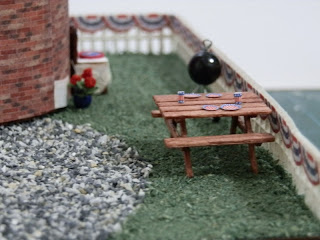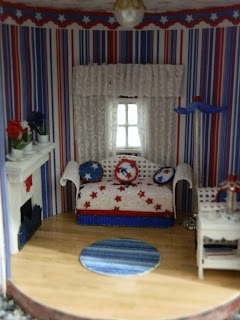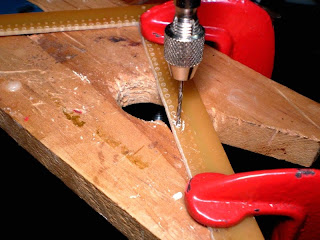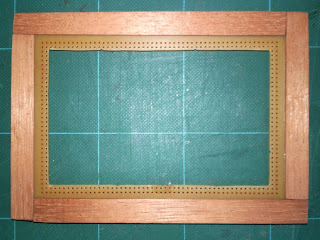Desta vez resolvi aceitar um desafio que me desafiou em VÁRIOS aspectos:
1) Participar de um desafio/troquinha lançado por um grupo de discussão online que participo
2) Fazer um item na escala 1:48 em quantidade (cada um faria 16 peças, que seriam redistribuídas para cada participante ganhar uma)
3) Montar uma cena na escala 1:48 em um TUBO!...
4) Montar um cenário no tema patriótico de outro país. Bem... por que não? :)
This time I decided to take on a challenge that really challenged me at SEVERAL levels:
1) Taking part in an international swap in an online group I belong to.
2) Make an 1:48th scale item in kind of mass production (each participant should make 16 of their item, which would later be redistributed to all participants)
3) Make a scene in 1:48th scale in a TUBE!...
4) Make a scene in a patriotic theme from another country. Well, why not? :)
Eram desafios pelos seguintes motivos:
1) Com a demora no envio e recebimento pelos correios e alfândegas, temia que meus itens não chegassem à tempo. Corri para fazer logo que tudo ficou acertado para não perder tempo. Fui a última a receber a minha caixa, acho, e só consegui montar a cena bem depois do prazo final. Mas isso eu já esperava, por causa da nossa alfândega. O importante é que não deixei ninguém na mão!! Desafio vencido!!! :)
Those posed real challenges for the following reasons:
1) International shipping takes a long time, and anything from or to Brazil (especially TO) takes even longer, due to our customs. I rushed to finish my items way ahead of time and shipped them asap. I was among the last one to get my swap box - which I quite expected - and was late to finish the challenge. But I did my part for the swap on time and no one had to wait for me! Challenge conquered! :)
 |
| Todos os itens recebidos... Olha a minha mesinha na frente (embaixo) All items from swap... Check my picnic table at the bottom |
2) Nunca consegui produzir nada em série. Sempre faço itens únicos. Achava que nem ia conseguir, mas deu certo! Desafio vencido!!! :)
2) I had never made any multiple items. All my minis are 'one of a kind', sort of speaking. I though I wouldn't be able to make it but... I did it!! Challenge conquered!! :)
 |
| Todas as mesinhas que fiz para enviar!... All picnic tables I made for the swap!... |
 |
| Embalando para enviar... Preparing for shipping... |
3) Everybody was using a salt box. Salt is sold in plastic bags here... Oatmeal boxes would be ok too, but that is sold in cardboard boxes or metal cans... I could make my own, but I decided to use a chips container. It's narrower and longer, but it worked fine. Challenge conquered!!! :)
 |
| A embalagem que usei... The container I used instead of the salt box... |
 |
| Cortada... Already cut... |
 |
| Andar de cima, já pronto, esperando pelos itens da troquinha! Top floor, finished, waiting for swap items! |
 |
| Estrutura completa montada e aberta. Structure finished and opened. |
4) A foreign theme was not the real challenge. The real challenge was to come up with a way to make the structure look like a Firecracker (to celebrate the 4th of July - British members worked on it as a Jubilee theme) while still making it 'liveable'. I discovered a multicolored LED 'thingy' on ebay and it arrived just before the swap box. I used it and it really worked, it does look like fireworks when turned on! Challenge conquered!!! :)
Ok, chega de falar... Aqui estão as fotos das cenas. Espero que gostem!
Ok, nuff said... Here are the pictures of my challenge. I hope you enjoy them!
 |
| Vista frontal, estrutura fechada. Front view, structure closed |
 |
| Visto de trás.Back view |
 |
| Lado direito, área de piquenique! :) Right side, picnic area!... :) |
 |
| Lado direito: jardim. Right side: garden. |
 |
| Piso superior: quarto de dormir. A cômoda fica na parede para aproveitar o espaço. Top floor: bedroom. Notice the vanity on the wall to save space. |
 |
| Detalhe do quarto More detail view of the bedroom. |
 |
| Piso inferior, sala. Bottom floor: living room. |
 |
| Lado direito da sala. Right side of the living room. |
 |
| Lado esquerdo da sala. Left side of the room. |
 |
| Os dois andares, estrutura aberta. Both floors, opened. |
 |
| Luz dos 'fogos de artifício' ligada. O quarto fica bem sexy, não é? ;) Firework lights on. The bedroom becomes quite a sexy place, right? ;) |
If you got curious to see how other participants in the swap finished their projects, here are a few links (for the ones who posted on a blog or fotolog):
Sheila (USA)


















